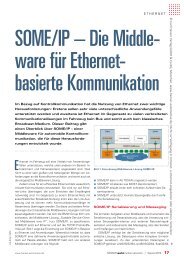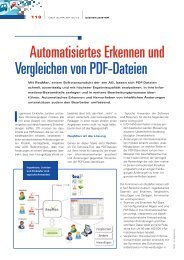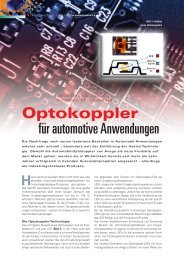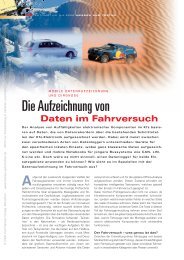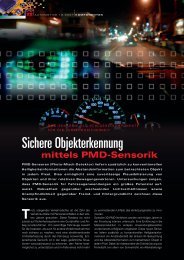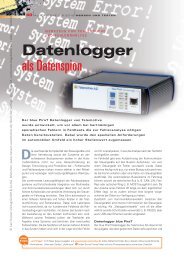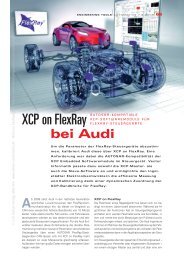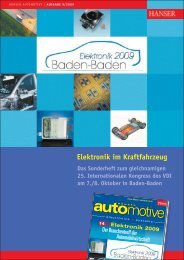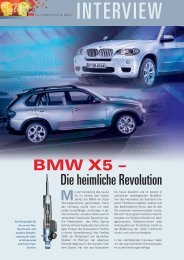Download - HANSER automotive
Download - HANSER automotive
Download - HANSER automotive
Create successful ePaper yourself
Turn your PDF publications into a flip-book with our unique Google optimized e-Paper software.
© Carl Hanser Verlag, München www.hanser-<strong>automotive</strong>.de Nicht zur Verfügung im Intranet- und Internet-Angeboten sowie elektronischen Verteilern<br />
All this had to be realized in a<br />
compact ECU (Fig. 2) that can<br />
operate within harsh environmental<br />
conditions. Some of the<br />
challenging factors are: limited<br />
mounting space, high ambient<br />
temperatures due to the power<br />
dissipation of the MOSFETS and<br />
strict EMC requirements.<br />
Also the software becomes a lot<br />
more complex than before and<br />
requires more memory and<br />
more calculation performance(e.g.<br />
for the Flexray protocol<br />
stack).<br />
8lA UTOMOTIVE 2008l SPECIAL EDITION FLEXRAY<br />
The microcontroller - V850E/PHO3<br />
A microcontroller that is able to satisfy all the above mentioned<br />
requirements is a rare thing. Taking into consideration<br />
NEC’s very well known high level of quality and long<br />
expertise in the chassis field (e.g. several million microcontrollers<br />
sold for electrical power steering) it was decided<br />
to use NEC’s V850E/PHO3 for the Active Steering and<br />
Rear-Wheel Steering projects (Fig. 3).<br />
In a “nutshell” the PHO3 features a high level of calculation<br />
power, a huge memory (1 MB), the capability to control<br />
BLDC motor actuators, an interface to the FlexRay network,<br />
is able to support the extended <strong>automotive</strong> temperature<br />
range (A2 grade) plus excellent EMC performance.<br />
In addition an integrated floating point unit has been implemented<br />
as this is required to support today’s approach of<br />
model based algorithm development.<br />
Many chassis applications have similar requirements to<br />
those above , but require more or less performance, resp.<br />
more or less memory. To cover this, NEC have created a<br />
dedicated product line, named “P” Series. The “P” series<br />
offers strong solutions for low, mid and high-end chassis<br />
applications.<br />
Key parameters of the FlexRay Network<br />
The FlexRay network is the key component which facilitates<br />
the fast exchange of data. This makes it possible for the<br />
actuators to behave in a coordinated way and demonstrate<br />
optimized quick reactions to compliment the physics of<br />
driving.<br />
As the FlexRay protocol was designed to allow a high flexibility<br />
a huge amount of parameters have to be chosen.<br />
One key parameter is the cycle time. As the FlexRay configuration<br />
should be unchanged for all cars within the 7<br />
Series platform and also future car series, it was a very difficult<br />
task to find the optimum balance required between<br />
network throughput and network load.<br />
Initially it was felt beneficial to have a high frequency of<br />
messages. But this would mean that seldomly sent messages<br />
would waste the network capacity. Finally it was<br />
decided to use a 10 Mbit transfer rate and 5 ms cycle time<br />
within the static and dynamic segments over a single channel.<br />
Although a network based purely on a passive bus<br />
would be preferable from cost<br />
point of view, it was finally decided<br />
to use a combination between the<br />
passive bus and star coupler. This<br />
was chosen because too many<br />
FlexRay nodes connected to one<br />
cable would detoriate the signal<br />
quality and hence limit the achievable<br />
bandwidth and quality of the<br />
signal transmission.<br />
V850E/PHO3 with Flex-<br />
Ray is running - What is<br />
next?<br />
Fig. 3: NEC V850E/PHO3 microcontroller<br />
As a result of the successful introduction<br />
of FlexRay into the first<br />
series project, other OEMs are now following and will present<br />
cars with FlexRay over the next couple of years. This<br />
means that FlexRay has been established as the <strong>automotive</strong><br />
high performance communication protocol and will<br />
become a standard interfaces within the <strong>automotive</strong> mass<br />
market. In order to support FlexRay for broader application<br />
areas the topology of the FlexRay network has to become<br />
much simpler. Also more flexible concepts are required<br />
e.g. synchronization. This is already on the way with the<br />
FlexRay protocol specification 3.0.<br />
The next big challenge for future chassis ECU’s will be cost<br />
reduction. High optimization potential still can be found in<br />
simplification of the functional safety concepts, by applying<br />
microcontrollers with enhanced functional safety support.<br />
This could help eliminating or at least simplifying components<br />
such as additional monitoring microcontrollers or<br />
supervision ASICs. But it could also dramatically reduce<br />
the efforts on the SW engineering side.<br />
Why not focus on the actual application SW and have the<br />
HW perform all of the diagnostics still being done in SW<br />
like memory tests, core self tests and plausibility check of<br />
safety-relevant calculation results? And why not reduce the<br />
efforts for functional safety validation and the assessment<br />
process in the same way?<br />
Wouldn’t it be a relief to present an “out-of-the-box” selfsafe<br />
microcontroller with proven safety integrity level rather<br />
than generating a new FMEA for each ECU variant,<br />
even though the same microcontroller is used?<br />
All this could be addressed by a generic functional safety<br />
concept for the microcontroller saving tremendous efforts to<br />
set up and validate a new functional safety concept for each<br />
and every product line. NEC Electronics has already started<br />
designing a new chassis microcontroller family, the Px4<br />
Series to meet these demands. It will be optimized for <strong>automotive</strong><br />
applications targeting IEC 61508 SIL3 certification<br />
and will use a single microcontroller to cover the span between<br />
a high level of functional safety at minimal costs. NEC<br />
has established a close cooperation with TÜV SÜD to monitor<br />
and assess the development of Px4 from the early conceptual<br />
phase to the final implementation in silicon.<br />
V850E/Px4 will feature an integral safety concept based on<br />
two redundant CPU subsystems checking simultaneous<br />
each others’ operation.



